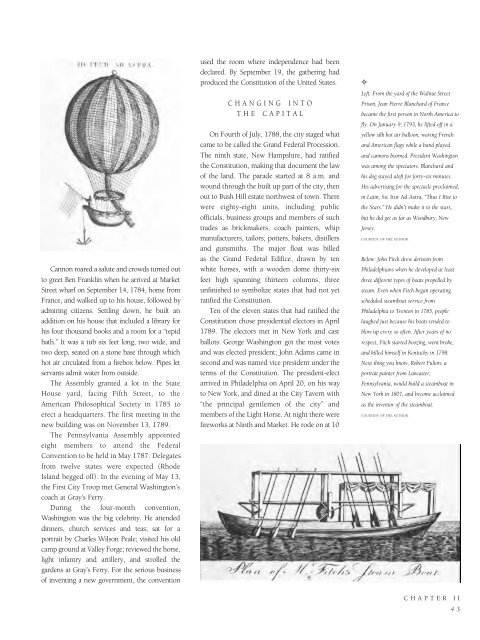Historic Philadelphia
An illustrated history of the city of Philadelphia, paired with the histories of companies, families and organizations that make the region great.
An illustrated history of the city of Philadelphia, paired with the histories of companies, families and organizations that make the region great.
Create successful ePaper yourself
Turn your PDF publications into a flip-book with our unique Google optimized e-Paper software.
Cannon roared a salute and crowds turned out<br />
to greet Ben Franklin when he arrived at Market<br />
Street wharf on September 14, 1784, home from<br />
France, and walked up to his house, followed by<br />
admiring citizens. Settling down, he built an<br />
addition on his house that included a library for<br />
his four thousand books and a room for a “tepid<br />
bath.” It was a tub six feet long, two wide, and<br />
two deep, seated on a stone base through which<br />
hot air circulated from a firebox below. Pipes let<br />
servants admit water from outside.<br />
The Assembly granted a lot in the State<br />
House yard, facing Fifth Street, to the<br />
American Philosophical Society in 1785 to<br />
erect a headquarters. The first meeting in the<br />
new building was on November 13, 1789.<br />
The Pennsylvania Assembly appointed<br />
eight members to attend the Federal<br />
Convention to be held in May 1787. Delegates<br />
from twelve states were expected (Rhode<br />
Island begged off). In the evening of May 13,<br />
the First City Troop met General Washington’s<br />
coach at Gray’s Ferry.<br />
During the four-month convention,<br />
Washington was the big celebrity. He attended<br />
dinners, church services and teas; sat for a<br />
portrait by Charles Wilson Peale; visited his old<br />
camp ground at Valley Forge; reviewed the horse,<br />
light infantry and artillery, and strolled the<br />
gardens at Gray’s Ferry. For the serious business<br />
of inventing a new government, the convention<br />
used the room where independence had been<br />
declared. By September 19, the gathering had<br />
produced the Constitution of the United States.<br />
CHANGING INTO<br />
THE CAPITAL<br />
On Fourth of July, 1788, the city staged what<br />
came to be called the Grand Federal Procession.<br />
The ninth state, New Hampshire, had ratified<br />
the Constitution, making that document the law<br />
of the land. The parade started at 8 a.m. and<br />
wound through the built up part of the city, then<br />
out to Bush Hill estate northwest of town. There<br />
were eighty-eight units, including public<br />
officials, business groups and members of such<br />
trades as brickmakers, coach painters, whip<br />
manufacturers, tailors, potters, bakers, distillers<br />
and gunsmiths. The major float was billed<br />
as the Grand Federal Edifice, drawn by ten<br />
white horses, with a wooden dome thirty-six<br />
feet high spanning thirteen columns, three<br />
unfinished to symbolize states that had not yet<br />
ratified the Constitution.<br />
Ten of the eleven states that had ratified the<br />
Constitution chose presidential electors in April<br />
1789. The electors met in New York and cast<br />
ballots. George Washington got the most votes<br />
and was elected president; John Adams came in<br />
second and was named vice president under the<br />
terms of the Constitution. The president-elect<br />
arrived in <strong>Philadelphia</strong> on April 20, on his way<br />
to New York, and dined at the City Tavern with<br />
“the principal gentlemen of the city” and<br />
members of the Light Horse. At night there were<br />
fireworks at Ninth and Market. He rode on at 10<br />
✧<br />
Left: From the yard of the Walnut Street<br />
Prison, Jean Pierre Blanchard of France<br />
became the first person in North America to<br />
fly. On January 9, 1793, he lifted off in a<br />
yellow silk hot air balloon, waving French<br />
and American flags while a band played<br />
and cannons boomed. President Washington<br />
was among the spectators. Blanchard and<br />
his dog stayed aloft for forty-six minutes.<br />
His advertising for the spectacle proclaimed,<br />
in Latin, Sic Itur Ad Astra, “Thus I Rise to<br />
the Stars.” He didn’t make it to the stars,<br />
but he did get as far as Woodbury, New<br />
Jersey.<br />
COURTESY OF THE AUTHOR.<br />
Below: John Fitch drew derision from<br />
<strong>Philadelphia</strong>ns when he developed at least<br />
three different types of boats propelled by<br />
steam. Even when Fitch began operating<br />
scheduled steamboat service from<br />
<strong>Philadelphia</strong> to Trenton in 1785, people<br />
laughed just because his boats tended to<br />
blow up every so often. After years of no<br />
respect, Fitch started boozing, went broke,<br />
and killed himself in Kentucky in 1798.<br />
Next thing you know, Robert Fulton, a<br />
portrait painter from Lancaster,<br />
Pennsylvania, would build a steamboat in<br />
New York in 1807, and become acclaimed<br />
as the inventor of the steamboat.<br />
COURTESY OF THE AUTHOR.<br />
CHAPTER II<br />
43
















